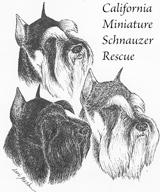California Miniature
Schnauzer Rescue

Schnauzer Health
Miniature Schnauzers are one of the healthier breeds of dogs but, as is the case with all living things, Schnauzers do get illnesses and some suffer from genetic and/or congenital health disorders.
If your Schnauzer is ill, or acting abnormally, take him or her to the vet promptly before the condition gets worse or, sadly, your pet dies. DON'T waste valuable time during which your Schnauzer may get sicker while you read the Internet.
Be aware that there is a lot of poor quality and outright incorrect veterinary advice on the Internet, often written by pet owners with no veterinary training. The following two Internet websites have veterinary health information prepared by veterinarians. Use them to learn more, AFTER having your Schnauzer seen by a qualified veterinarian.
Health Research and Genetic Tests
CMSR supports the efforts of the American Miniature Schnauzer Club and the AKC Canine Health Foundation to help eliminate genetic diseases in Miniature Schnauzers and to help find effective treatments for disorders found in the breed.
Myotonia Congenita DNA Test
A DNA test for Myotonia Congenita became available from the Josephine Deubler Genetic Disease Testing Laboratory of the University of Pennsylvania on March 2, 2000. It was the first DNA test available for a disorder in Miniature Schnauzers. It gives Miniature Schnauzers the ability to completely eliminate Myotonia Congenita from the breed.
Each animal needs be tested only once during its lifetime. The cost of the test is $75 per animal, much less than laboratories are charging for DNA tests for disorders in other breeds.
On October 11, 2001, Dr. Urs Giger of the University of Pennsylvania reported that the Josephine Deubler Genetic Testing Laboratory had tested about 400 Miniature Schnauzers, and that more than 10% had proved to be carriers of Myotonia Congenita. He further reported that pedigree analyses suggest that most of the carriers are related to Ch. Blythewood Shooting Sparks, and that the test results provide evidence of this genetic mutation in Australia and Europe, as well as in the U.S. and Canada. As of April 2002, another affected and several more carriers had been found. As of October 2002, Dr. Giger reports that there are several carriers as to whom the lab does not have sufficient pedigree information to determine if they are descended from Shooting Sparks, but still none definitively established not be be descendants of Shooting Sparks.
Information on the DNA Test For Myotonia Congenita, including instructions on how to submit blood samples.
Type A and B Progressive Retinal Atrophy (PRA) DNA Tests
Although they share the same name of “PRA”, there are several known—and also many more unknown/uncharacterized—genetic abnormalities (mutations) that cause PRA in dogs. For many years, OptiGen (a testing laboratory affiliated with Cornell University) has provided a DNA test, “Type A PRA”, that is able to detect one form of this disease. Through OptiGen’s Free DNA Testing/PRA Research program, in which it has tested dozens of pedigreed Miniature Schnauzers who have been diagnosed by veterinary ophthalmologists as having PRA, OptiGen has determined that the Type A form of PRA is very rare in the breed. None of these PRA cases (in recent years) have been due to the Type A PRA mutation. These new cases formed the basis of research aimed at identifying other genes and mutations responsible for PRA in the breed.
During 2018, 11 Miniature Schnauzers were tested for Type A PRA and were found to be clear, as were all Miniature Schnauzers tested for Type A PRA in prior years; that is, exactly 0 Miniature Schnauzers have been found to be Type A PRA carriers or affecteds since the test became available to breeders..
New Genetic Test for PRA: Type B PRA Risk Variant
In collaboration with Drs. Doreen Becker and Gus Aguirre at the University of Pennsylvania, OptiGen discovered a new genetic variant that explains a large portion of PRA cases in the Miniature Schnauzer. Based on that discovery, OptiGen now offers a genetic test called Type B PRA test for Miniature Schnauzers. This DNA test is able to identify dogs who carry zero, one or two copies of the Type B PRA risk variant. The results of this test are intended to assist breeders when selecting the breeding pairs in order to prevent matings that would result in Type B PRA-affected puppies.
Test results for Type B PRA are reported as:
· Homozygous wild type/Clear: the dog carries NO copies of the risk variant; will not develop Type B PRA
· Heterozygous/Carrier: the dog carries ONE copy of the risk variant; will not develop Type B PRA
· Homozygous Risk Variant: the dog carries TWO copies of the risk variant; at high risk of developing Type B PRA
The Type B PRA test results are reported as Risk Variants because, although dogs carrying two copies of the variant are very likely to develop PRA, a subset (14%) of the research sample set that were homozygous for the variant did not develop PRA by 7 years of age. It is not clear at this time whether the variant represents a causal mutation—and that other factors influence the “penetrance” of the mutation—i.e. its ability to cause disease—or if the variant is a genetic marker that resides near the causal mutation. OptiGen and the University of Pennsylvania scientists will continue research aimed at better understanding this question.
Dogs who are Homozygous Risk Variant for Type B PRA have a high risk of developing Type B PRA. Within the research sample set, these dogs had an 86% chance of developing PRA, based on the initial research group of 108 genotyped dogs.
Type B PRA is inherited as an autosomal recessive disease and in order to prevent producing offspring that will develop this form of PRA, at least one parent should be DNA tested prior to breeding and shown to be Homozygous wild type/Clear for the Type B PRA risk variant..
Other forms of PRA in the breed:
The newly developed Type B PRA DNA test does not explain all cases of the disease in the breed. It is concluded that there is at least one more form of PRA (in addition to Types A and B) present in the breed. In other words, if a dog has been tested Homozygous wild type/Clear or Heterozygous/Carrier for the Type B PRA risk variant, it can still develop (another form of) PRA, as well as transmit that other disease-causing genetic variant to offspring. Of the 76 PRA-clinically diagnosed Miniature Schnauzers in the research sample set, 42 (55%) of the cases were shown to be homozygous for the Type B risk variant. The remaining 45% of cases were either heterozygous (11%) or Clear (34%) of the Type B Risk Variant. In several of these cases, genome analysis by Genome Wide Association Studies (GWAS) indicated that the disease mapped to a different genomic region than Type B PRA thus confirming the presence of another PRA disease locus.
Check the OptiGen web site for details on how to obtain the Type A and Type B tests and for further developments in the research, www.optigen.com.
Total (paying customer samples) MS-Type B PRA stats for 2017 (January 1-December 31, 2017): 122, consisting of:
Normal: 95
Carrier: 27
Affected: 0
During the first quarter of 2018, 94 Miniature Schnauzers were tested for Type B PRA:
Clear - 64
Carrier - 27
Variant - 3
Countries testing this period include: Denmark, Germany, Iceland, Italy, Poland, Russia, Sweden & US.
Persistent Muellerian Duct Syndrome (PMDS) Test
In late 2014, OptiGen began offering a test for PMDS in Miniature Schnauzers. PMDS in the Miniature Schnauzer is caused by a mutation in the MISRII gene and is inherited as a sex-limited autosomal recessive trait. This means that the disease is only observed in males that carry two copies of the mutation (are “homozygous”), for the MISRIImutation. Females that are homozygous for the mutation do not develop disease but may transmit the mutation to offspring. Carriers of one copy of the MISRII mutation do not have the disease.
MDS clinical symptoms/phenotype:
Males with PMDS have complete male internal genitalia however they also develop some of the female internal genitalia that can interfere with descent of the testes into the scrotum. Approximately half of the males with PMDS are either uni-laterally or bi-laterally cryptorchid. PMDS males with descended testes are fertile, however they frequently have reduced sperm count. PMDS males with bi-lateral cryptorchidism are sterile. Uni-lateral cryptorchid PMDS males have much reduced fertility. As in other cryptorchid dogs, PMDS-affected males commonly develop Sertoli cell tumors. Pyometra (infection of the uterus) is also reported in PMDS males. Because approximately 50% of the PMDS males are not cryptorchid and females do not show the disease, the frequency of the MISRII mutation in Miniature Schnauzers may be surprisingly high. A random selection of 20 unrelated Miniature Schnauzers previously tested for Type A PRA at OptiGen revealed that 7 of the dogs carried one copy of the MISRII mutation. These carriers were submitted from dogs originating in Europe, Asia and North America so the mutation does appear to have wide geographic distribution. As more dogs are tested, OptiGen will be able to provide updated mutation frequency to those who are interested.
During the 2nd quarter of 2016, one Miniature Schnauzer was tested for PMDS and was found to be normal.
Check the OptiGen web site for all the details on how to obtain the test, www.optigen.com.
Home |
Rescue Dogs—No. Cal. |
Rescue Dogs—So. Cal. |
Sponsor or Adopt a Special Needs Dog |
Adopted | Tributes | In Memoriam |
Breed Information | Taking Your New Dog Home |
Grooming |
Publications | Links | Legislation |
